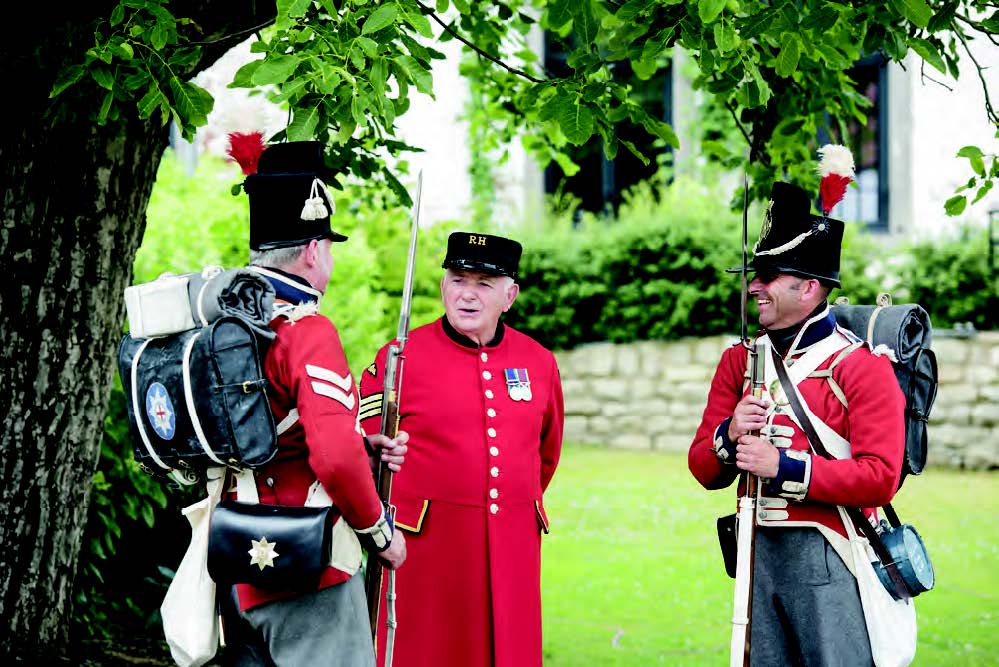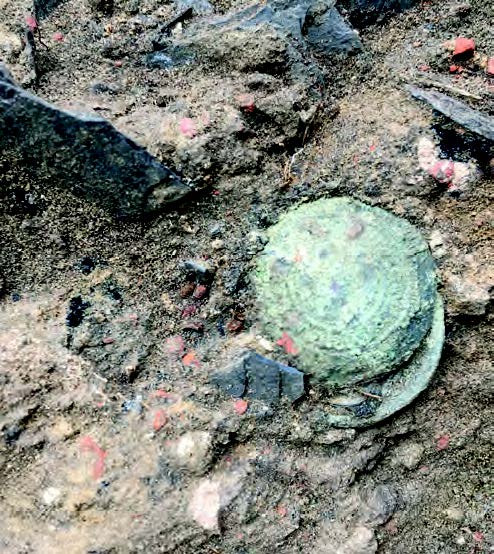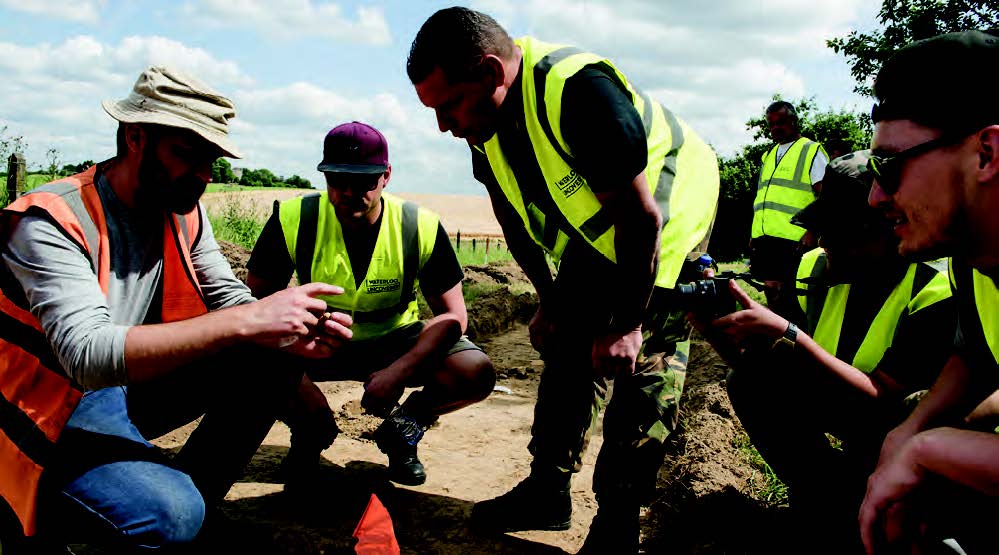Waterloo Uncovered founders Mark Evans and Charlie Foinette have a shared history, as well as a deep friendship. They studied archaeology together at University College London before joining the army. Both chose the Coldstream Guards, the British regiment that played a vital role in the allied victory at Waterloo and continues to see active service across the world today. In their military careers they led men in combat, saw war up close and personal, and felt its impact first-hand – on the battlefield and at home.
In 2010, returning from Afghanistan, Mark was diagnosed with Post Traumatic Stress Disorder (PTSD) and his friend Charlie was on hand to help. It was Charlie’s powers of persuasion – “If you haven’t seen a Doctor by Monday I’ll bloody drag you there myself” – that set Mark on the way to recovery. It wasn’t quick, and almost four years later when the MoD began a project to support veterans through archaeology, Charlie thought Mark would be an ideal candidate. They were both amazed by what they discovered – archaeology could help veterans recover and support their transition into civilian life.
This revelation got the friends thinking. Inspired by their shared past and the approaching bicentenary of the Battle of Waterloo, the notion struck them of combining the worlds they knew so well to create an entirely new kind of social enterprise – a bold new venture to involve serving personnel and veterans in unearthing the secrets of the world’s most famous land battle – Waterloo Uncovered.
Turning Conflict into Collaboration
As they began to plan Charlie and Mark were amazed to find out how little archaeology had previously been carried out at the battlefield. It was incredible, as Charlie said, “like knowing where Pompeii was buried, but never lifting a trowel to excavate it.”
Eyewitness accounts are abundant but recounted through the fog of the battlefield – often some time after the event – they can be biased, patchy and confusing. Somewhere between the written record and the physical evidence provided by archaeology lies the truth about what happened, and what it might have been like for a soldier to fight and die there.
Even more shocking was that 200 years after the battle the archaeology was almost gone – looted by metal detectorists, disturbed by modern farming and eroded daily by the natural environment. What was left needed to be recorded now, or risk being lost forever.
Charlie and Mark acted fast and sought the help of some of Europe’s top archaeologists and historians who readily joined the project. Universities, companies, governments, organisations and individuals all jumped on board, seizing the chance to be a part of such an ambitious plan.
So, armed with the best minds and latest technology (geophysics, smartphones, laptops, augmented reality, social media) they developed a plan: an international collaboration between the military, veterans and archaeologists to produce a world-class archaeological project.




While each team member has their own motivation there is a common thread that binds them together: a desire to work alongside members of the modern military – themselves scarred by war – in the painstaking task of piecing together this extraordinary moment in history, to be a part of a project that is truly ground-breaking.
Discovery aiding recovery
Archaeology is proven to support recovery from injury. A multifaceted discipline, it offers opportunities to everyone – no matter their ability or injury. In particular, it is very helpful to those who suffer or have suffered from PTSD.
Waterloo Uncovered provides a twelve-month support programme to beneficiaries which facilitates the development of individual goals before signposting them to the next phase of their journey. Fundamentally, support is offered to Veterans and Serving Military Personnel in five key areas: recovery, wellbeing, transition, education and vocation.
The excavation not only provides interest and focus but is also meditative. Its outdoors and team-based nature is particularly appealing to soldiers, and the chance to do work that will be appreciated and seen by the public makes it even more rewarding.
What’s more, archaeology offers a real educational and vocational experience, a chance to be part of the civilian workplace under relaxed yet professional conditions. A number of veterans who have taken part in the excavations have carried on with archaeology, or have been inspired into education.
Finding Peace from War
2019 saw Waterloo Uncovered’s biggest and most diverse group of participants yet. Participants included both veterans and serving personnel, represented all branches of the military, and came from across Europe as far as America. Amongst these participants was Grace Lewis-Flanagan, who served in the RAF for 23 years before being discharged due to injury. From having been in “a dark place,” she describes taking part in Waterloo Uncovered as “like being handed a lifeline.”
The educational and practical elements of the excavation were therapeutic for Grace, as were the extracurricular activities put on in the evenings for the participants, and the camaraderie of being part of a team made up of those with similar life experiences and struggles.
“From day one I felt like myself again,” she explains, “I was smiling and laughing with the feeling of being part of a team. The archaeology reignited my interest in history and I found a new love of model making and poetry.”
Since taking part in the project, Grace’s newfound interest in archaeology has continued, and she has built on the skills she learnt in Belgium: “I’ve also been metal detecting and have attended some excavations since returning. All in all, the experience was invaluable in helping in my recovery.”
One of her fellow 2019 participants, Oliver Horncastle, was one of the youngest serving soldiers to attend last year’s excavation at only 22. Oliver is a serving Coldstream Guardsman who was injured in 2018, and joined the Waterloo Uncovered team the next summer as a way to aid in his rehabilitation and return to active service. Like Grace, he benefitted from the camaraderie of the dig, describing the team as “like a big family”:


Although Oliver was already a keen metal detectorist, this was his first experience with archaeology, and he was lucky enough to uncover the first find of the 2019 season: a British musket ball. Oliver’s luck continued over the next two weeks of digging, and he was responsible for two of the major finds of the season: an unexploded 6-inch howitzer shell that had to be seized by the Belgian bomb squad as it may have still been live, and a Coldstream Guards button found at the North Gate of Hougoumont which the regiment defended. The latter discovery was particularly poignant for Oliver. As a Coldstream Guardsman himself, Oliver was happy to find a button belonging to his regiment, describing it as “like solid gold” to him – but he also looked forward to finding objects which will tell the stories of soldiers beyond the Coldstream Guards:
“One Coldstream Guards button is excellent, but there was so much more at play here – so many people made so many sacrifices here, and there are other people to represent.”
Summing up the impact of Waterloo Uncovered on its veteran participants, Oliver had this to say:
“Some people have had horrific accidents and horrific things happen to them. This project is doing them a huge amount of good, you can see it day on day, week on week. Some of these guys are coming out of their shells in ways they probably haven’t done in a great many years.”
You can find out more about Waterloo Uncovered, their work with veterans and serving military personnel, and about the archaeology and history of the Battle of Waterloo through their website (http://www.waterloouncovered. com) and their popular YouTube channel (https://www.youtube.com/c/WaterlooUncovered), or find them on Facebook, Twitter and Instagram.
Watch this space for more insight into Waterloo Uncovered’s archaeological discoveries on the battlefield of Waterloo.
If you would like to hear more about the Waterloo Uncovered story, please contact Mike Greenwood by email, [email protected]. If you’ d like to support the work of the charity, go to: https://waterloouncovered.com/donate/
Photography by:
Chris van Houts,
Deborah M Bernstein,
Emily Glass



